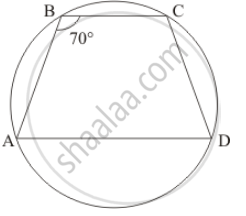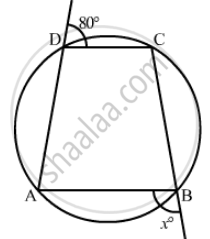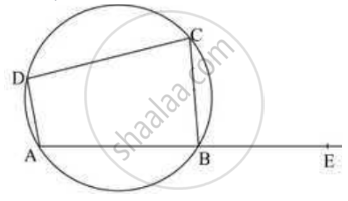Advertisements
Advertisements
Question
ABCD is a cyclic trapezium with AD || BC. If ∠B = 70°, determine other three angles of the trapezium.
Solution
If in cyclic quadrilateral `angle B = 70°` , then we have to find the other three angles.

Since, AD is parallel to BC, So,
`angleB + angleA = 180 ` (Alternate interior angles)
`70 + angleA = 180`
`⇒ angle A = 180 - 70 = 110°`
Now, since ABCD is cyclic quadrilateral, so
`angle A + angle C = 180`
`⇒ 110 + angle C = 180`
`⇒ angle C = 180 - 110 = 70°`
And,
`angle B + angleD = 180`\
`⇒ 70 + angleD = 180`
`⇒ angleD = 180 - 70 = 110°`
APPEARS IN
RELATED QUESTIONS
A chord of a circle is equal to the radius of the circle. Find the angle subtended by the chord at a point on the minor arc and also at a point on the major arc.
ABCD is a cyclic quadrilateral whose diagonals intersect at a point E. If ∠DBC = 70°, ∠BAC is 30°, find ∠BCD. Further, if AB = BC, find ∠ECD.
Two circles intersect at two points B and C. Through B, two line segments ABD and PBQ are drawn to intersect the circles at A, D and P, Q respectively (see the given figure). Prove that ∠ACP = ∠QCD.

Let the vertex of an angle ABC be located outside a circle and let the sides of the angle intersect equal chords AD and CE with the circle. Prove that ∠ABC is equal to half the difference of the angles subtended by the chords AC and DE at the centre.
In a cyclic quadrilateral ABCD, if ∠A − ∠C = 60°, prove that the smaller of two is 60°
In the given figure, ABCD is a cyclic quadrilateral. Find the value of x.

Prove that the circles described on the four sides of a rhombus as diameters, pass through the point of intersection of its diagonals.
Circles are described on the sides of a triangle as diameters. Prove that the circles on any two sides intersect each other on the third side (or third side produced).
ABCD is a cyclic quadrilateral. M (arc ABC) = 230°. Find ∠ABC, ∠CDA, and ∠CBE.

If bisectors of opposite angles of a cyclic quadrilateral ABCD intersect the circle, circumscribing it at the points P and Q, prove that PQ is a diameter of the circle.
